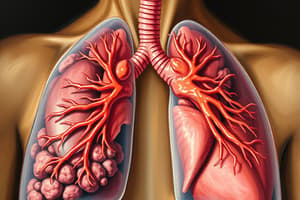Podcast
Questions and Answers
What does a high V/Q ratio indicate in the context of pulmonary function?
What does a high V/Q ratio indicate in the context of pulmonary function?
- High perfusion with low ventilation.
- Low ventilation and low perfusion.
- Normal ventilation with high perfusion.
- High ventilation but low perfusion. (correct)
Which condition is least likely to cause a low V/Q ratio?
Which condition is least likely to cause a low V/Q ratio?
- Pneumonia.
- Chronic Obstructive Pulmonary Disease (COPD).
- Asthma.
- Pulmonary embolism. (correct)
Which factor can significantly reduce ventilation (V) in the lungs?
Which factor can significantly reduce ventilation (V) in the lungs?
- Improved respiratory muscle strength.
- Obstruction in the airways. (correct)
- Increased lung compliance.
- Enhanced blood flow to the pulmonary capillaries.
What is the normal V/Q ratio approximately considered to be?
What is the normal V/Q ratio approximately considered to be?
Which treatment may be appropriate in addressing V/Q mismatch in respiratory conditions?
Which treatment may be appropriate in addressing V/Q mismatch in respiratory conditions?
How does gravity affect perfusion (Q) in the lungs?
How does gravity affect perfusion (Q) in the lungs?
What can chronic obstructive pulmonary disease (COPD) lead to in terms of V/Q distribution?
What can chronic obstructive pulmonary disease (COPD) lead to in terms of V/Q distribution?
What effect does vascular obstruction have on perfusion (Q)?
What effect does vascular obstruction have on perfusion (Q)?
Asthma primarily leads to which of the following effects on ventilation?
Asthma primarily leads to which of the following effects on ventilation?
Which symptom is most indicative of severe hypoxemia?
Which symptom is most indicative of severe hypoxemia?
Which underlying condition is a common cause of hypoxemia?
Which underlying condition is a common cause of hypoxemia?
Which diagnostic test is primarily used to assess blood oxygen levels?
Which diagnostic test is primarily used to assess blood oxygen levels?
What is a key treatment option for managing hypoxemia?
What is a key treatment option for managing hypoxemia?
What oxygen saturation level is classified as moderate hypoxemia?
What oxygen saturation level is classified as moderate hypoxemia?
Which respiratory condition is least likely to lead to hypoxemia?
Which respiratory condition is least likely to lead to hypoxemia?
Flashcards are hidden until you start studying
Study Notes
Ventilation and Perfusion
Definitions
- Ventilation (V): The process of air moving in and out of the lungs.
- Perfusion (Q): The flow of blood to the pulmonary capillaries, allowing gas exchange.
Importance
- Optimal gas exchange (oxygen and carbon dioxide) relies on adequate ventilation and perfusion.
- Imbalances can lead to respiratory and cardiovascular issues.
V/Q Ratio
- V/Q Ratio: A measure of the relationship between ventilation and perfusion in the lungs.
- Normal V/Q Ratio: Approximately 0.8.
- High V/Q: Indicates high ventilation but low perfusion (e.g., pulmonary embolism).
- Low V/Q: Indicates low ventilation but high perfusion (e.g., pneumonia).
Factors Affecting Ventilation
- Airway patency (obstructions can decrease V).
- Lung compliance (stiff lungs may lower V).
- Respiratory muscle strength (weak muscles can reduce V).
Factors Affecting Perfusion
- Blood flow (can be influenced by cardiac output and vascular resistance).
- Gravity (affects perfusion in different lung regions when standing/sitting).
- Vascular obstruction (e.g., blood clots may reduce Q).
Clinical Applications
- Ventilation-Perfusion (V/Q) Scan: Imaging test to assess V/Q ratio; important for diagnosing pulmonary embolism.
- Treatment of Conditions:
- V/Q mismatch can be treated with supplemental oxygen or mechanical ventilation.
- Addressing underlying causes like fluid management in congestive heart failure for improved perfusion.
Pathophysiology
- Conditions causing V/Q mismatch include:
- Chronic Obstructive Pulmonary Disease (COPD): May lead to uneven distribution of V and Q.
- Asthma: May increase resistance and decrease effective ventilation.
- Pulmonary Edema: Can impair gas exchange despite adequate ventilation.
Summary
- Balanced ventilation and perfusion are crucial for effective gas exchange.
- Understanding V/Q relationships aids in diagnosing and managing respiratory conditions.
Ventilation (V)
- The process of air moving in and out of the lungs.
Perfusion (Q)
- The flow of blood to the pulmonary capillaries, allowing gas exchange.
Importance of V and Q
- Adequate ventilation and perfusion are essential for efficient gas exchange (oxygen and carbon dioxide).
- Imbalances between V and Q can lead to respiratory and cardiovascular problems.
V/Q Ratio
- A measure of the relationship between ventilation and perfusion in the lungs.
- Normal V/Q Ratio is approximately 0.8.
- High V/Q indicates high ventilation but low perfusion (e.g., pulmonary embolism).
- Low V/Q indicates low ventilation but high perfusion (e.g., pneumonia).
Factors Affecting Ventilation
- Obstructions in the airway can decrease ventilation.
- Reduced lung compliance (stiff lungs) can lower ventilation.
- Weakness of the respiratory muscles can reduce ventilation.
Factors Affecting Perfusion
- Blood flow is influenced by cardiac output and vascular resistance.
- Gravity affects perfusion in different lung regions when standing or sitting.
- Vascular obstructions (e.g., blood clots) can reduce perfusion.
Ventilation-Perfusion (V/Q) Scan
- An imaging test used to assess V/Q ratio.
- Important for diagnosing pulmonary embolism.
Treatment of V/Q Imbalance
- Supplemental oxygen or mechanical ventilation can be used for V/Q mismatch.
- Addressing underlying causes, such as fluid management in congestive heart failure, can improve perfusion.
Conditions Causing V/Q Mismatch
- Chronic Obstructive Pulmonary Disease (COPD) can lead to uneven distribution of V and Q.
- Asthma can increase airway resistance and decrease effective ventilation.
- Pulmonary edema can impair gas exchange despite adequate ventilation.
Summary
- Balanced ventilation and perfusion are crucial for effective gas exchange.
- Understanding V/Q relationships aids in diagnosing and managing respiratory conditions.
Symptoms of Hypoxemia
- Shortness of breath or difficulty breathing is a common symptom of hypoxemia, indicating the body is not getting enough oxygen
- Rapid heart rate (tachycardia) is the body's attempt to compensate for low oxygen levels by pumping more blood
- Cyanosis, a bluish discoloration of the lips, skin, or nails, occurs due to decreased oxygen levels in the blood
- Confusion or altered mental state can be caused by hypoxemia affecting brain function
- Fatigue or lethargy can be a sign of low oxygen levels, as the body struggles to function properly
- Headaches can be a symptom of hypoxemia, as the brain requires a consistent oxygen supply
- Dizziness or lightheadedness may occur because of reduced oxygen reaching the brain
Underlying Diseases
- Chronic Obstructive Pulmonary Disease (COPD) is a chronic lung disease that can lead to hypoxemia
- Asthma exacerbations can cause temporary narrowing of airways, leading to hypoxemia
- Interstitial lung disease, a group of lung conditions, can damage the lungs, impairing oxygen transfer
- Pneumonia, an infection of the lungs, can interfere with oxygen exchange
- Pulmonary embolism, a blockage of blood vessels in the lungs, can reduce oxygen flow
- Anemia, a condition where the body lacks enough red blood cells to carry oxygen, can contribute to hypoxemia
- Congenital heart defects can cause problems with blood flow, leading to oxygen deficiency
Diagnostic Tests
- Arterial blood gas (ABG) analysis directly measures oxygen levels in the blood
- Pulse oximetry non-invasively estimates oxygen saturation by measuring light absorption in the blood
- Complete blood count (CBC) can identify anemia, which contributes to hypoxemia
- Chest X-ray can reveal conditions affecting the lungs, such as pneumonia or pulmonary embolism
- CT scan of the chest can provide detailed images of the lungs, aiding in diagnosis
- Spirometry (lung function tests) assess lung capacity and airflow, helping diagnose conditions like COPD
Treatment Options
- Supplemental oxygen therapy provides extra oxygen to increase blood oxygen levels
- Medications (bronchodilators, corticosteroids) can help open airways and reduce inflammation in cases of asthma or COPD
- Treatment of underlying conditions such as antibiotics for pneumonia is crucial for resolving hypoxemia
- Mechanical ventilation provides assisted breathing for severe cases of hypoxemia
- Lifestyle modifications such as smoking cessation and pulmonary rehabilitation can improve lung function and reduce hypoxemia risk
Oxygen Saturation Levels
- Normal oxygen saturation: 95-100%
- Mild hypoxemia: 90-94%
- Moderate hypoxemia: 80-89%
- Severe hypoxemia: below 80%
Studying That Suits You
Use AI to generate personalized quizzes and flashcards to suit your learning preferences.




